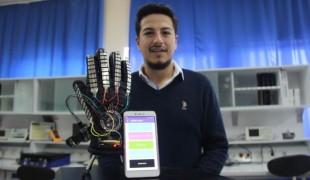- 8034
- 530
- 9
- 11
- 0
- Help Ukraine
About the solution
With this solution, patients who are deaf or mute can communicate more easily with the general public.
“My niece wears the gloves, pairs them with her phone or mine, then starts signing. I’m able to understand what she’s saying,” Roy explained.
Sign-IO works by recognising different signed letters and transmitting this data to an Android app, that later vocalises this information.
The app allows the users to set the language, gender and pitch of the audio voice (accuracy results of 93%).
One of the most important features of these gloves is the speed at which the signs are being vocalised.
“People speak at different speeds and it’s the same with people who sign – some are really fast, others are slow. So we integrated that into the mobile application so that it’s comfortable for anyone to use,” he observed.
According to Roy, this device can help the user with more than just daily communication.
“It fights the stigma associated with being deaf and having a speech impediment. If the gloves look cool, every kid will want to know why you are wearing them,” he noted.
Sign-IO, still a prototype, is the winner of the hardware trailblazer award at the American Society of Mechanical Engineers 2017. It was placed 2nd runners-up at the Royal Academy of Engineering Leaders in Innovation Fellowship in London. It’s also on the shortlist for the 2019 Africa Prize for Engineering.
The inventor aims to put at least two pairs of gloves in every Kenyan special needs school.
“The general public in Kenya doesn’t understand sign language, so when she goes out, she always needs a translator. Imagine that dependency over the long term; how much that plagues or impairs her progress in life. When it affects you personally, you see how hard people have it in life. That’s why I’ve really strived to develop this project to completion.”I was trying to envision how my niece’s life would be if she had the same opportunities as everyone else in education, employment – all aspects of life,” he said.
The project is open source and the code can be found on Roy’s website.
Adapted from: https://bit.ly/2CewpvT
More info: http://www.royallela.com/
This solution shall not include mention to the use of drugs, chemicals or biologicals (including food); invasive devices; offensive, commercial or inherently dangerous content. This solution was not medically validated. Proceed with caution! If you have any doubts, please consult with a health professional.
DISCLAIMER: This story was written by someone who is not the author of the solution, therefore please be advised that, although it was written with the utmost respect for the innovation and the innovator, there can be some incorrect statements. If you find any errors please contact the patient Innovation team via info@patient-innovation.com
-
-
405
-
2
-
4745

Student invents glove that translates sign language into text
COMMUNICATION: Communicating, whether by speaking, listening, or other means
Social interaction
Blindness
Visual Impairment
Hearing Disorders
Congenital Deafness
Speech Disorder
App (Including when connected with wearable)
Body-Worn solutions (Clothing, accessories, shoes, sensors...)
5 Senses support devices: (glasses, hearing aids, headphones...)
Vision problems
Difficulty speaking or understanding speech
Hearing loss or ringing in the ears (tinnitus)
Regaining sensory function
Promoting inclusivity and social integration
Improving Speech and Communication
Neurology
Ophthalmology
Otorhinolaryngology
Turkey
-
-
-
357
-
0
-
4125

Using AI to allow blind people to find familiar faces
COMMUNICATION: Communicating, whether by speaking, listening, or other means
Social interaction
Blindness
5 Senses support devices: (glasses, hearing aids, headphones...)
Body-Worn solutions (Clothing, accessories, shoes, sensors...)
App (Including when connected with wearable)
AI algorithm
Assistive Daily Life Device (to help ADL)
Difficulty communicating with environment
Confusion
Regaining sensory function
Promoting self-management
Promoting inclusivity and social integration
Improving Speech and Communication
Raise awareness
Ophthalmology
Pediatrics
United States
-
-
-
283
-
0
-
3252

Project OUVER - collaborator creates 'do-it-yourself' open-source solution for deaf or hard of hearing
COMMUNICATION: Communicating, whether by speaking, listening, or other means
Listening to music
Social interaction
Congenital Deafness
App (Including when connected with wearable)
5 Senses support devices: (glasses, hearing aids, headphones...)
Hearing impairment
Hearing loss or ringing in the ears (tinnitus)
Regaining sensory function
Promoting self-management
Promoting inclusivity and social integration
Otorhinolaryngology
Portugal
-
 en
en